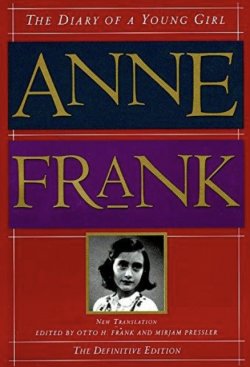Alona Kharina, Ukraine

Review of The Diary of a Young Girl by Anne Frank. Translated from the Dutch by Susan Massotty. New York: Doubleday, 1995.
We are all in one circle.
“After every war, they always say: it will never happen again, war is such a horror, and it must be avoided at all costs. And now people are at war with each other again, and it never happens otherwise.” This observation, worthy of a contemporary philosopher, was made by Anne Frank, a 13-year-old Jewish girl, in her diary. As is well known, Anne documented being in hiding from the Nazis for two years, after Germany invaded the Netherlands in 1940. We can take her book as an example of the accumulation and release of the trauma caused by adverse events, through conversation with ourselves, our shadow side. We can also take it as an example of forgiveness. It is possible for us, as readers, to witness life in a meager room during the war, without any external contacts. We observe Anne’s mental maturation and hear testimonies of unfriendly love for her mother and painful love for her father. Her memoir is an opportunity to explore issues of morality, faith, hope, and freedom, through the prism of the tragic experiences of one family – like so many families fleeing war today, to survive. They plant flowers on someone else’s land, wear someone else’s clothes, eat someone else’s food, and learn someone else’s language, showing that we are in the same circle, so we must ask for help and accept it.
I write this while living in Ukraine during the war Russia has brought here. When I close my eyes, I don’t see the victims of war as strangers. I see hundreds of dead bodies lying on the road. I look at them and merge this loss with my own, imagining that my father, brother, son, and a friend are there. Why? Empathy is one way to keep your human face and find the strength to live on. One might envy people who know how to transform this pain into anger and socially significant action. My path is from tears to ice, with the right to experience fear and anxiety, and, when all the horror gradually subsides, I learn to live with vulnerability.
Anne also knows vulnerability. She needs to be heard. Her desire to show her bleeding wound is apparent throughout her diary. It is worth noting that reflection and self-reflection is an appropriate method of therapy. Each reader confronts the grief of Anne’s war; this brave girl gives excellent advice on how to deal with this grief. She looks at us, the readers, from the cover of her book with deep eyes and a genuine smile. She teaches us to speak aloud about our experiences, to share them openly, to stay honest with ourselves, and to not lose hope. “So many things happened as if the earth had overturned! But I am still alive, and this, according to my father, is the most important thing,” Anne wrote on July 8, 1942.
Vulnerability also means asking for help. Fortunately, Anne’s family had food, water, clothing, and personal hygiene items sent by caring people. Sometimes, Anne conveys a whole, touching story in a few details about simple necessity. “Eight residents have one basin and one chance to bathe in it for a week, on Saturday. Everyone has their place for that.” The place could be the kitchen, the office, the toilet, and so on. Lack of privacy traumatizes the individual, but also the collective consciousness of all family members. This closed space is an abyss for free people, but Anne, as a strong-minded person, finds a way to fight and to live on. Keeping her diary was one way. Continuing her education was another. While staying in the shelter, she had access to textbooks in art, history, and Greek and Roman mythology. She was interested in literature, foreign languages, and collecting. “You must courageously endure fears, troubles, and disasters. More than ever, and you have to grit your teeth to keep from screaming,” – an entry from June 1944.
Anne Frank’s diary is not just a chance to lift the curtain and spy on someone else’s life, or even to learn about how decent human beings cope with trauma. It is also a horrific testimony about the Nazis’ inhuman treatment of Jews. It teaches us to seek the truth about such atrocities, to hold it in our memory without distorting it, and to use it for good – which, as Anne shows us, requires that we remain compassionate. The cycle in history Anne describes will not leave anyone passive – least of all today’s Ukrainian readers. We must accompany her diary entries with our own screams, whispers, tears, and silences. Indeed, we are familiar with all these languages. But as long as we can see, like Anne, “cloudless sky and sunshine,” we have no right to surrender to grief. Anne’s goal was to become a writer, and this goal has come true. Today her diary has been translated into more than 60 languages. “I want to live on, even after my death,” she wrote on April 5, 1944. Her autobiographical legacy is an opportunity for contemporary readers to engage in dialogue – with ourselves and others – as a way to rethink our life values, to find psychoanalytic meaning, to share personal insights and experiences, and to attempt to make our trauma just a memory.
